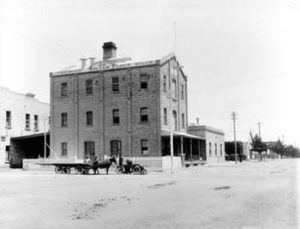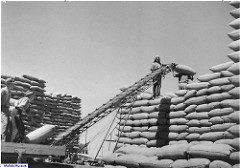Flour mill yard. Flour mill yard. Flour mill yard. Flour mill yard. Flour mill yard.
LIFE WAS NOT ALWAYS EASY AROUND THE FLOUR MILL YARD
By A.E. Coate

I had been at the Flour Mill several years when Martin Gorman of the bag department died in February, 1929. In fact I had been his assistant for over three years and had a good knowledge of the work involved and of the customer service. I was put in charge of the bag department and handed the yard keys, about ten in all, for the various gates and sheds. I did not know it then, but I was to carry those keys (with one or two added over the years) up into the 1970’s.
It was a sprawling yard area, with the stables located at the western end near the back of the police sergeant’s house. A spur line ran nearby on to which railway wagons were shunted to await loading. The Hume Pipe Works were also located in this vicinity.
The working area was fenced off from Clive Street at the silos around the various sheds and back to the ROW (now Emu Lane – Ed.) at the back of Richardson and Co (The Plaza in 1988) and through the alley to Austral Terrace. There were about nine gates to be opened each morning and closed at 5 p.m. The ROW as mentioned was shut off in those days.
Some of the gates suffered damage now and again by being struck by railway wagons and in later years by big transports. There was not much clearance in later years as trucks and wagons got bigger. Two of the big gates near the ROW at the Mill end and at the silo end were hit within days of erection.
During harvest season, up until the late 40s, there would always be a long line of farm wagons, carts among them, waiting at the silo gates to unload. Weighing was done with portable scales and the bags handled singly, a tally clerk being on duty. This was a very time consuming process, although the real constriction was the cleaner which removed all the husks and straw before the grain was elevated into the silos.
As greater amounts of wheat were grown and motor trucks carted ever bigger loads, a weighbridge was installed, faster cleaning machinery introduced and a pit for bulk handling put in. The operator would weigh the truck with load in and then weigh the empty truck out and thus establish the weight of wheat delivered. The upgraded facilities could not keep pace with the increase in grain and there was always a long line of trucks coming in and going out during the height of harvest. Later still, when semi-trailers appeared they had to be weighed in three sections, coming and going, because although the bridge was large enough when first installed it couldn’t cope with these big trucks in one go.
There were accidents – cut fingers on metal stencils, falls off ladders, or by being knocked over by slides of flour at the shed. Some were serious enough to require hospital treatment; like the time when Charlie Cattanach came off a ladder in the flour shed. He was attending to the flour chute that had jumped the socket holder at the top of the big elevator. John Albert (Dolly) Gray was knocked down by a slide of flour and sustained a broken nose. Aubrey Fleay was winded by a slide of rolled wheat in the shed, and Joe Loan had his leg crushed between a railway wagon and the silo ramp.
I came very close to being injured or even killed in 1933 by a fall of flour from a 20 bag high stack and, but for the providence of God, I may not be alive today. It was the direct result of a stack of flour being topped up and partly built onto another stack. In this case I heard, as well as sensed, the creak of the stack coming away from the main body and dived for cover under a railway truck, hitting the ground seconds before bags of flour went spilling over the truck and into the yard. I emerged shaken and gravel bruised, but otherwise unhurt. One of the men shut his eyes and felt in his pocket for the death levy money. He and others thought it was all over for me. Having cleared away the mess of flour and broken bags, the work of loading the export order went on again.
Another of the men in the Mill itself had his clothes ripped off when he came in contact with the main driving shaft in the basement below the ground floor.
Minor accidents were mostly treated on the spot with the help of the ‘medicine chest’; a small box containing a few bandages, a bottle of iodine and an odd assortment of knick-knacks. I remember when Len Mitter cut his finger, iodine was poured into the raw wound and Len went out to it cold and had to be revived. Most of us had recourse to the iodine bottle at some time or other without any ill effects.
When the silos were full, the stacking of bagged wheat began and the dangers in building big stacks of wheat were always real. The elevators were not long enough to reach up to some stacks in the old shed area because they were often twenty and more bags high and much had to be manhandled up planks. One had to be careful to get the ‘feel’ of the bag across the shoulders or he may soon have back trouble or even fall off the plank if the bag of wheat or flour was lopsided on his shoulders.
Bags of wheat weighing 180 to 200 pounds (80 to 90 kg) were not easy to bear if not set on the shoulders correctly. The same applied to a barrow load of bricks being pushed up a narrow plank into the kiln. The men who worked the Mill brick-works had to get the knack of loading them so as not to overbalance up the plank.
Bricks are heavy things to handle and control (The Coate’s used to have a brick-works at Woodanilling in the 1920’s). Often bags of wheat and flour had to be lifted directly off the floor. Any farmer will know it is hard work loading up that way. I have helped put bags of wheat and other grains up onto trucks or wagons by means of horse pulled cradle, which threw the bag up onto the tray.
Much of the work in the Mill yard was hard and heavy going. There were few mechanical aids and often few men. At least three men committed suicide and twice that number died of heart attacks from the 1950’s to 1970’s. Others, like myself, suffered angina attacks as a result of stress, overwork, and in my own case, considerable worry and anxiety coupled with the strain of the loss of family members – three within 13 months. The many problems involved, together with the strain, got too heavy for me and I decided to retire.
For some years prior to this a forklift had become part of the yard equipment and much of the heavy work of lifting was minimised. However, much still had to be manipulated by manhandling the stuff, and I had already suffered two hernia operations since 1943. Indeed, for some in the ‘bloom or blight of life’s day’ the Mill yard could well have been named ‘Wits End Corner’, but there were those acts of goodwill that revealed human nature and understanding. Sympathy at its best.
Like the time in the 1970’s when I was in much pain as a result of a chill in the back and trying to lift a consignment of 150 pound (70 kg) flour bags to standing position from the flour shed floor and keep the wheelers going as they loaded a rail wagon. Mr. Wally Haddleton, the then Chairman of Directors in the new Oat Milling Company, came into the shed and with a cheerful word of encouragement took over the job and finished it for me.
I remember the many loads of 6 foot (1.8 m) white gum logs brought into the Mill furnaces by Dave McLeod and his team to keep the steam up and the Mill going. Summer and winter and the months in between, Dave would trundle his loads into the Mill through the area now occupied by the Commercial Bank.
The boilers and engines were housed in the rooms and lean-to against the Mill building on the then open laneway, and the diesel generators were in the brick building on the opposite side. Many a dead cat found its way by human propulsion into the fiery furnaces, as did unwanted records from around town. In winter the furnace area was a warm place to meet and discuss the topics of the day, but in summer a place to keep well away from if one like to keep cool.
The smoke from the high chimney stack no longer wafts over Katanning town. It has gone the way of so many other landmarks. The only reminder of it ever having been there is an insert of flooring boards just above and beside the top of the back…
??? Pages following are missing from the original transcript.

